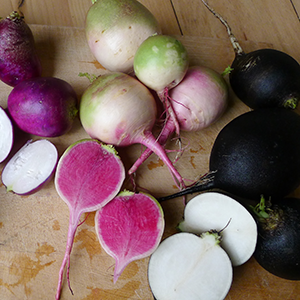
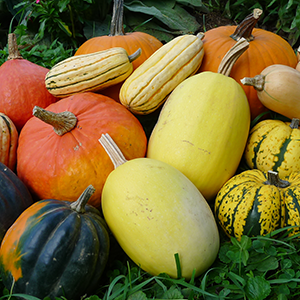
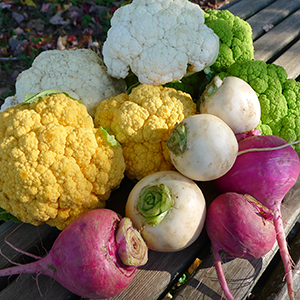
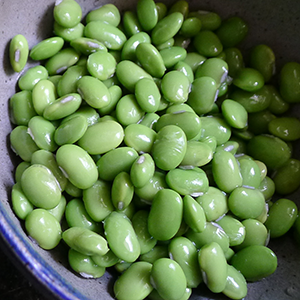
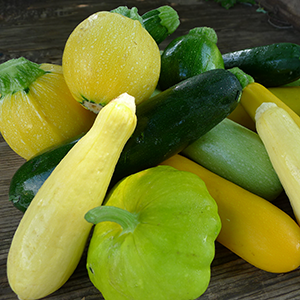
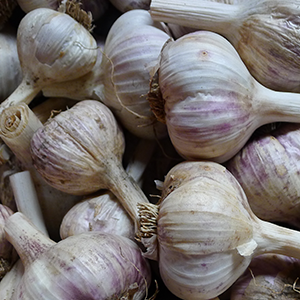



News and Notes | The Anchor Run Blog
Posts Filtered by Month - May 2024 |
Show Recent Posts
May 27, 2024
June Salads!
by Linda Dansbury
June Salads!
by Linda Dansbury

Borage flowers, in the foreground, are a fun, cucumber-flavored addition to salads.
The pick up room is so full of deliciousness! Hope you are enjoying your harvests - if you have a method or recipe you would like to share with fellow members, please email me at lindadansbury@comcast.net and please put Anchor Run in subject line so I can find your message. This past week has really felt like summer so I made salads and will include another one in this week's list that I plan on making today.
Arugula - just plain, delicious arugula dressed with lemon juice, olive oil salt and pepper - that's it! As an aside, if you have button or cremini mushrooms, slices of them are a great addition as are thinly sliced fennel and/or celery.
Mixed lettuces, hakurei turnips, radishes - made a Dijon vinaigrette. This was delicious and pretty with the colors of the turnips and radishes!
Bok choy, kale, hakurei turnips, green garlic, cilantro - will make the Asian Style Slaw (on this site) today to enjoy with grilled local pastured pork chops!
Radishes, mint, chives (scallions can be used) - enjoyed the Radishes with Goat Cheese Dip - so yummy and light as a warm evening snack.
Kale, hakurei turnips (for added crunch), green garlic, cilantro - for an easy weeknight dish, try the Kale Rice Bowl. I tend to change it up with veggies/greens I have on hand.

May 27, 2024
Strawberry Daze
by Linda Dansbury
Strawberry Daze
by Linda Dansbury

Strawberries are here!! One of the most anticipated crops of the year, and so delicious. New crops will be showing up each week so enjoy the diversity!
Strawberries - everyone knows how to eat them, but just a couple of words on storage. Store berries dry in open containers in the refrigerator. If your berries are wet when you bring them home, place them on a kitchen towel and allow to dry before putting them in the fridge. Do not rinse them until ready to eat - wet berries rot very quickly. Some years, depending on Mother Nature, the harvest is very large and you may wonder how to freeze some for use later (think ice cream, smoothies, strawberry crumble, frozen strawberry daiquiri). Simply cut the little green top off, place in a single layer on a cookie sheet and place in freezer. Once frozen, place in freezer bag or plastic container where berries will keep well for months.
Swiss chard - is in the same family as spinach so has a similar nutritional profile and can be used in many of the same recipes. Small leaves can be eaten raw, but it is mostly enjoyed cooked. Saute or stir fry it up alone or with other greens and aromatics. It makes a great Creamed "Spinach" as well. The stems and leaves need different cooking times, so remove the stems and cook those longer. One easy and delicious way to enjoy chard is to saute. Heat oil in a large saute pan. Add sliced or chopped onion, chopped chard stems, and a dash (or more) of red pepper flakes or a chopped up chili pepper. Once starting to soften add chopped green garlic or garlic scape (coming soon). Add chopped chard leaves to pan, stir constantly until desired doneness. Add salt and pepper and any chopped herbs you like. If you choose a recipe that you don't want to use the stems, place in plastic bag in freezer to use later in making veggie stock. There are several Swiss chard recipes on this site.

May 27, 2024
Berry Goodness
by Farmer Derek
Berry Goodness
by Farmer Derek

Strawberry season is here!
Harvest #4 (Week B) should include kale, salad radishes, hakurei turnips, bok choy, daikon radishes, rutabaga, cilantro, dill, mini head lettuce, romaine lettuce, swiss chard, komatsuna, lettuce mix, and green garlic. Some items will be a choice. U-pick should include herbs and strawberries. Please remember your scissors.

May 27, 2024
Workshifts this Week (5/27/24)
by Farmer Derek
Workshifts this Week (5/27/24)
by Farmer Derek

Farmers Connor, Alex, and Gabby.
We're progressing slowly but surely through carrot weeding and could definitely use your help this week!
This week's workshift schedule:
- Wednesday 5/29 6-8pm
- Friday 5/31 10am-12pm
- Sunday 6/2 9-11am
Bring gloves, water, a hat, sturdy shoes, and a pad for kneeling (if necessary for you).
We meet under the large red maple at the end of the barn by the pick up room.
Please be here by the scheduled start time (it might be hard to find us in the fields otherwise).

May 27, 2024
"Now What?!" Workshop
by Gia Yaccarino
"Now What?!" Workshop
by Gia Yaccarino

Hosted by longtime member Gia Yaccarino on Saturday 6/1, Sunday 6/2, Saturday 6/8, and Sunday 6/9, all at 11 am.
Please sign up on the website here if you are planning to attend!
Maybe you are a new member, maybe you’ve been a member for a while. Either way – this workshop is for you!
In the barn, everything made sense while you were putting your share into your bags to bring home. At home, it suddenly became very overwhelming once you began unpacking! We have all been there; it is part of the CSA learning curve.
Let us help you make the most of your farm share!
Being a member of a CSA opens the door to so many topics! At this workshop we will talk about:
- Resources: books, websites, Anchor Run CSA website (Recipes and Veggies 202 – it has pictures)
- How to keep your veggies as fresh as possible once they are in your refrigerator.
- The pros and cons of different preservation techniques (freezing, fermenting, canning, dehydrating).
- “Tools of the trade”, which I find invaluable.
- Before you compost: radish greens are edible!
- Composting, composting at the farm; what and what not to include in a compost pile, vermicomposting.
- Solar Cooking.
- How to keep your veggies as fresh as possible once they are in your refrigerator.
- The pros and cons of different preservation techniques (freezing, fermenting, canning, dehydrating).
- “Tools of the trade”, which I find invaluable.
- Before you compost: radish greens are edible!
- Composting, composting at the farm; what and what not to include in a compost pile, vermicomposting.
- Solar Cooking.
We will share recipes based on farm produce that our families love. And by share – I mean taste and provide copies of the recipes. Pestos - don’t limit yourself to Basil. What to do with all those greens? Veggie Hash! The list goes on! This is a casual, enlightening event that will enhance your experience of the CSA. Hope to see you there!

May 27, 2024
Juggle
by Farmer Derek
Juggle
by Farmer Derek

Embarking on a long hot day of transplanting last week.
Perhaps we're now past the peak of transplanting after putting beans, edamame, lettuce, herbs, chard, basil, peppers, and eggplant in the ground last week, plus another round of beans, edamame, lettuce, and herbs today. Later this week we'll plant watermelon, followed by zucchini, cucumbers, cantaloupe, and sweet potatoes next week. With so much space now occupied by crops that live a long life over the summer months, we're about to transition to the crop maintenance phase of the season.
Tomatoes, for example, need trellis support and weekly pruning; peppers require a stake and twine system to buttress their branches with levels of twine added as plants grow taller; and potatoes require hilling, or mounding, of soil around the plants to encourage additional tubers. It's also peak season for weeds, so their management (aka elimination) will require our undivided attention.
For some crops, like watermelon, cantaloupe, zucchini, and cucumbers, we install fabric ahead of time to suppress weeds and give the crop a head start. For others, about two weeks after transplanting, we go in with stirrup hoes and scuffle the soil when weeds are small and most vulnerable. Some long-lived bare ground crops, like carrots and beets, may require 2-3 cultivations; most others get by with just one. Slow-growing crops like carrots and onions normally need hand weeding as well.
We're never able to remove all of the pest and weed issues from the system but through experience and planning we can mostly ensure the successful harvest of a crop by giving it timely attention.

First hilling of potatoes typically occurs right around Memorial Day.

May 27, 2024
U-Pick Information
by Farmer Dana
U-Pick Information
by Farmer Dana
- Check the u-pick board in the hallway for u-pick crops and amounts before picking. Amounts listed are per share per week.
- Only crops listed on the board are available for u-pick.
- U-pick crops and weekly allotments can be harvested any day of the week, 8am–8pm Monday through Sunday of your pick up week. So if you can’t do your u-pick on your scheduled pick up day, feel free to come back any other day that week.
- BYO scissors for herbs and flowers.
- We provide half-pint, pint, and quart u-pick baskets for members to measure and harvest into. Please save these and reuse them as much as possible. If you have some that are still in good shape at the end of the season we'll gladly accept them back.

May 20, 2024
A Different kind of Cole Slaw
by Linda Dansbury
A Different kind of Cole Slaw
by Linda Dansbury

Dinner preparation using turnip tops and bottoms, bok choy, and green garlic.
It hasn't felt much like late spring recently, but the unofficial start of summer is next weekend! I love salads all year, and they vary by what we have in the fridge. There are A LOT of recipes on this site to help you enjoy your harvest. Simply click on For Members at the top of the page (you don't even have to log in). Recipes shows up in the pull down menu so click on that. Then, you can search on the ingredient in which you are needing inspiration. These recipes have been selected/developed with what is in season; at the same time so many of them include multiple veggies. There are also suggestions for alternative ingredients. Please try them out. Here are a couple things I made this past week:
Bok choy, radish, kale, green garlic, cilantro - you don't need cabbage to make a delicious cole slaw. My family loves the Asian Style Cole Slaw that is on this site.
Kale, green garlic, watermelon radish, komatsuna - made a delicious stir fry. I make these regularly with whatever I have on hand. The radish added wonderful crunch here. There are so many stir fry recipes on the internet - pick the seasoning blends you like. I normally go with some form of soy sauce and a bit of sesame oil.
Lettuce mix, arugula, radish - a simple lemony vinaigrette is so good on these spring greens. Rough recipe is: about 2 Tablespoons lemon juice plus a bit of the zest, 1 teaspoon Dijon mustard, 1-2 teaspoon honey, a bit of the green garlic and a bit of onion or shallot (to taste), a pinch or so of salt, a couple grinds of pepper, about a quarter cup of extra virgin olive oil. Place all in a container with a tight fitting lid and shake till it's blended. Dress salad right before enjoying - store leftovers in fridge.
Green garlic - made garlic bread - finely chop green garlic and place in some olive oil, allow to soak in there for a bit to meld the flavors. Spread on bread of your choice and bake in oven at about 425 until lightly browned. Enjoy.

May 20, 2024
What to Do With Those "Extra" Greens
by Linda Dansbury
What to Do With Those "Extra" Greens
by Linda Dansbury

Future snow peas.
Receiving all of these greens can be somewhat overwhelming - you don't want to waste them, but how do you use them? One of the things I have come to do throughout the season is freeze greens for later use. This includes the tops from things like turnips, radishes and beets (if I don't use them in another dish). I learned this simple method years ago from a fellow member. Bring a large pot of water to a boil. Wash and chop up the greens you want to freeze and place in the sink in a large colander. When water boils, carefully pour over the greens and let drain. When cool enough to handle, squeeze out the greens. I squeeze them into balls. Place in a freezer bag in freezer. Later, when you make a soup or stew or need extra flavor for veggie stock, pull a ball of greens out of the bag and add to your dish.
Another way to use up greens is to make pistou and/or pesto - most greens can be made into pistou/pesto, including kale and arugula. Use within a few days or freeze and use later - I love using pesto as the dressing for pasta salads. There are many recipes for pesto on this site and a recipe for Classic Pistou as well.
This week's share should include rutabaga, daikon radishes, along with turnips, salad radishes and green green garlic, so you can roast them if you like. In the fall/winter I typically add rosemary or thyme to the pan at the beginning of cooking, but to brighten it up for spring, chop a bunch of herbs and sprinkle over the roasted veggies at the end, along with a drizzle of olive oil. Leftovers make the best frittatas.
Enjoy the harvest!!

May 20, 2024
Spring Treats
by Farmer Derek
Spring Treats
by Farmer Derek

Future strawberries.
Harvest #3 (Week A) should include kale, arugula, salad radishes, hakurei turnips, bok choy, daikon radishes, rutabaga, cilantro, dill, mini head lettuce, komatsuna, lettuce mix, and green garlic. Some items will be a choice. The herb garden will be open for u-pick starting this week. Please remember your scissors.

May 20, 2024
Workshifts this Week (5/20/24)
by Farmer Derek
Workshifts this Week (5/20/24)
by Farmer Derek

Friend of the farm.
This week's workshift schedule:
- Wednesday 5/23 6-8pm
- Friday 5/24 10am-12pm
- Sunday 5/26 9-11am
Bring gloves, water, a hat, sturdy shoes, and a pad for kneeling (if necessary for you).
We meet under the large red maple at the end of the barn by the pick up room.
Please be here by the scheduled start time (it might be hard to find us in the fields otherwise).

May 20, 2024
"Now What?!" Workshop
by Gia Yaccarino
"Now What?!" Workshop
by Gia Yaccarino

Hosted by longtime member Gia Yaccarino on Saturday 6/1, Sunday 6/2, Saturday 6/8, and Sunday 6/9, all at 11 am.
Please sign up on the website here if you are planning to attend!
Maybe you are a new member, maybe you’ve been a member for a while. Either way – this workshop is for you!
In the barn, everything made sense while you were putting your share into your bags to bring home. At home, it suddenly became very overwhelming once you began unpacking! We have all been there; it is part of the CSA learning curve.
Let us help you make the most of your farm share!
Being a member of a CSA opens the door to so many topics! At this workshop we will talk about:
- Resources: books, websites, Anchor Run CSA website (Recipes and Veggies 202 – it has pictures)
- How to keep your veggies as fresh as possible once they are in your refrigerator.
- The pros and cons of different preservation techniques (freezing, fermenting, canning, dehydrating).
- “Tools of the trade”, which I find invaluable.
- Before you compost: radish greens are edible!
- Composting, composting at the farm; what and what not to include in a compost pile, vermicomposting.
- Solar Cooking.
- How to keep your veggies as fresh as possible once they are in your refrigerator.
- The pros and cons of different preservation techniques (freezing, fermenting, canning, dehydrating).
- “Tools of the trade”, which I find invaluable.
- Before you compost: radish greens are edible!
- Composting, composting at the farm; what and what not to include in a compost pile, vermicomposting.
- Solar Cooking.
We will share recipes based on farm produce that our families love. And by share – I mean taste and provide copies of the recipes. Pestos - don’t limit yourself to Basil. What to do with all those greens? Veggie Hash! The list goes on! This is a casual, enlightening event that will enhance your experience of the CSA. Hope to see you there!

May 20, 2024
So...Much...Planting
by Farmer Derek
So...Much...Planting
by Farmer Derek

From spring greens to future tomatoes, the Hoop Tunnel gets a makeover.
Wow, such an incredible amount of crops are going in the ground right now. In the span of two months, way more than half the farm's acreage gets planted. The first rush starts at the very end of March or early April when all of the cold tolerant spring crops start to go in the ground. Think lettuces, kale, cabbage, greens, peas, onions, potatoes, beets, chard, etc. Then in mid-May the summer crop rush commences, once the threat of frost is over, as the greenhouse and hoop house are filled to the max. Summertime crop transplants tend to take up a lot of space because the plants get large and require more growing room at a young stage. For example, 18 tomato plants, 50 pepper plants, or 38 zucchini occupy the same amount of space as 128 lettuces or 288 onions.
It takes a good amount of time to get all these summer crops in the ground because so much bed feet is devoted to them (most of them are planted one row per bed compared to three rows for most other crops). One planting of peppers and eggplant alone, for example, will occupy the same amount of space as an entire season's worth of lettuces planted over 6 months (about 5,000 feet). Over the past couple of weeks we've transplanted about 10,000 feet of crops (cherry tomatoes, tunnel tomatoes, zucchini, cucumbers, tomatillos, flowers, beans, lettuce, herbs, chard, scallions, winter squash) and will plant another 10,000 feet this week (peppers, eggplant, basil, celery, watermelon, plus more beans and lettuces). After that it will be safe to say we're well past the midpoint of the season's transplanting requirements even though we'll still plant weekly into September. Large plantings of sweet potatoes, next season's strawberries and garlic, and fall brassicas, lettuces, and beets are still ahead of us.

May 12, 2024
Tunnel Vision
by Farmer Derek
Tunnel Vision
by Farmer Derek

Turnips, radishes, and kale in the Hoop Tunnel.
Harvest #2 (Week B) should include kale, arugula, salad radishes, hakurei turnips, bok choy, daikon radishes, watermelon radishes, garlic chives, komatsuna, lettuce mix, and green garlic. Some items will be a choice. No u-pick yet.

May 12, 2024
Workshifts this Week (5/13/24)
by Farmer Derek
Workshifts this Week (5/13/24)
by Farmer Derek

Misty morning transplanting.
This week's workshift schedule:
- Thursday 5/16 6-8pm
- Friday 5/17 10am-12pm
- Sunday 5/19 9-11am
Bring gloves, water, a hat, sturdy shoes, and a pad for kneeling (if necessary for you).
We meet under the large red maple at the end of the barn by the pick up room.
Please be here by the scheduled start time (it might be hard to find us in the fields otherwise).

May 12, 2024
Spring Veggie Assortment
by Linda Dansbury
Spring Veggie Assortment
by Linda Dansbury

Succulent strawberries will be here soon! Go pollinators!
Welcome to Week 2 of the 2024 harvest! I have been a part of Anchor Run Farm since its inception, assisting fellow members with how to enjoy their harvest. We realize that sometimes the amount we receive each week can be a bit overwhelming, especially for new members. Here are thoughts on some of the veggies we will see in the pick up room this week.
Komatsuna - I had not heard of this green that is in the same family as mustard, broccoli, etc. As such, it is very nutritious. Store it as you do other greens in plastic bags or containers with a towel or paper towel so it doesn't sit in water, which hastens rotting. Young leaves can be added to salads, while the stems and older leaves are delicious steamed, in stir fries and soups. Komatsuna can be used as a substitute for any recipe calling for bok choy or mustard greens.
Green Garlic - Simply garlic that has not formed its large bulb yet. I love that the farm gives us garlic over such a long period of time. Green garlic is more mild and does not store as well as hardened off garlic that we receive in the fall does, so store in the fridge. Use the entire plant! Just cut off any tough leaves and use the rest! Because of the more mild flavor, long cooking will dull the flavor somewhat so I really like to use in stir fries, dips, guacamole, etc.
Garlic Chives - An herb in the same family as chives, but as the name says, they are garlicky in flavor. Cooking will cause the flavor to dull, so for best results add them at the very end of a cooked dish, or chop them into salads or dips, potato and pasta salads.
Bunch Radishes and Turnips - These are both equally delicious sliced in salads, enjoyed with your favorite dip/hummus, roasted and sliced and sautéed with herbs. Don't toss the greens! They can be stir-fried, added to soups or stews, or frozen to use at a later time!

May 12, 2024
Back and Forth
by Farmer Derek
Back and Forth
by Farmer Derek

Baby beets receiving some much needed water a few weeks ago.
Now that we've returned to a more normal spring weather pattern with an 85-degree day followed by one with a high of 55 degrees and precipitation seemingly every-other day, we can at least suspend irrigating outdoor crops for the time being. After three weeks without any rain, we've been fortunate to receive some very delicate and drawn out precipitation events and not the inundating heavy rainfall we've become more accustomed to. We're right in the middle of the mad planting season and every week has a long list of crops that need to be planted, so fields that aren't too soggy are much appreciated right now. It's also the time of transitioning to summer season planting with beans, basil, tomatoes, zucchini, cucumbers, peppers, tomatillos, and flowers all needing to find homes in the fields. Fortunately most of the crops have a place and a space ready for them and now we just need to find the time to get them in the ground in between rain events. Some aren't quite ready to be transplanted, but by the end of next week most will be in their final location to thrive and grow for a few months.
It's mid-May and we're on the cusp of peak weed season. Abundant moisture plus warm temperatures equals rapid weed seed germination and growth. Thus, workshift season commences! CSA members participating in workshifts is an integral component of successfully growing organic crops here and we greatly value your help in the fields (which is why we offer a discount on share prices if you work)! Look for anywhere from two to four workshifts scheduled each week, weather depending. Typically we host one on Sunday mornings, one on a weeknight, and a couple during weekdays. Log in and sign up through the calendar on our website. See you in the fields!

May 12, 2024
Spring Ideas
by Linda Dansbury
Spring Ideas
by Linda Dansbury

Watering in freshly transplanted crops in the herb garden, including lavender, sage, oregano, thyme, lemon balm, catnip, cilantro, dill, nasturtium, borage, parsley, calendula, and mint.
Spring veggies are so welcomed after the dreary winter weather, which this year doesn't seem to go away. Here are a few of the things I enjoyed this past week.
Turnips and turnip tops - I made a delicious Japanese soup - it did have a few steps, but it was well worth it. Cooked cubed up turnips in a dashi broth until tender. Placed in blender and blended until smooth and put back in pot to keep warm. Chopped up turnip tops and boiled for 2 minutes. Placed in blender with a bit of the turnip soup and whirred up until smooth. Put turnip soup in bowls and topped with some of the greens puree and swirled it to make it look pretty. Serve warm. It was delicious for a cool night.
Lettuce, arugula - I love tender spring salads and no need to to dress heavily. Just a bit of salt and pepper, a squeeze of lemon juice and a drizzle of a mild olive oil. Slice watermelon radishes, salad radishes or turnips into the mix if you like. Enjoy!
Bok choy, komatzuna, green garlic - Yummy simple stir fry. Separated leaves from stalks and chopped all. Sautéed a bit of onion with chopped green garlic. After a minute added the bok choy stalks and komatsuna stem, mixed them around for a minute and added the greens. Added a bit of soy sauce and sesame oil at the end. Mixed well and enjoyed.

May 12, 2024
Instagram Page Update
by Farmer Dana
Instagram Page Update
by Farmer Dana
To our members that follow the farm on Instagram, unfortunately our account was hacked within the last month and we lost our old page and content. We started a new account and if you're interested in following us, @anchorrunfarm is our new 'handle'. It was sad to lose the photographic history of the farm in that format, but we are inspired to start fresh and build a new page. Definitely all small potatoes in the grand scheme of things. Thanks for your support as always!

May 6, 2024
A Note On Storage
by Farmer Dana
A Note On Storage
by Farmer Dana

Farmer Dana sowing the off-bed cover crop mix of oats and white clover amongst the pea patch.
Over the years many members have asked what the best way to store farm veggies is. Ours is probably not the best storage method but it works just super for us. We hang on to plastic bags that we acquire through other purchases and repurpose them, rinsing and drying them between uses. Big bags (like 2 gallon zip lock bags) work the best. In general we group similar items in the bags with each other. For example with this harvest I put lettuces together, kale and bok choy together, the roots and green garlic together, and the swiss chard all by its little lonesome. Then store in the refrigerator, not in the very back or on the top, or wherever is susceptible to freezing in your fridge. Easy peasy.

May 6, 2024
Pick Up Days and Times Plus Farm Communication
by Farmer Dana
Pick Up Days and Times Plus Farm Communication
by Farmer Dana

The farm crew transplanting another round of spring crops on a beautiful day.
- Pick up days are Tuesdays 1-8pm, Thursdays 1-8pm, and Saturdays 9am–12pm (new hours). You're assigned a permanent pick up day but you may temporarily switch to a different day or week.
**Please note there is usually a rush right at 1 pm. If you're looking to avoid a crowd, consider the 3 o'clock hour.**
- If you need to temporarily switch your pick up day and/or week, please email us by 5pm Monday prior to your pick up day.
- After each pick up we'll look at the sign in sheets and if your name is not checked off we will contact you to see if you did miss pick up and want to reschedule.
- We sent an email earlier last weekend reminding you of your designated pick up day and week. Please email us if you did not receive it. It was sent to the primary account holder's email address. If you did not receive it in your inbox, check spam or another folder. It's a good idea to make sure our emails end up in a place you'll notice them since this is how we communicate farm information, events, etc.
- You can log in and view your information on your members page, including share size, pick up day, work history, and balance.

May 6, 2024
Pick Up Essentials
by Farmer Dana
Pick Up Essentials
by Farmer Dana

Farmer Gabby planting potatoes a few weeks ago.
- BYO baskets/bags/boxes to bring your harvest home. Sometimes we have donated shopping bags on hand to pack your shares in, but sometimes we don’t! (Also, our produce is not packaged in any way, so bringing your own bags is important if you want produce kept separate within a larger container. This is a small way we can reduce farm plastic waste. One member last year let us know that their plastic waste is reduced by half when they are picking up shares from the farm - great news!)
- Check off your name on the sign-in sheet before collecting your share from the barn. Organized by share size and alphabetically by last name.
- Follow harvest amounts written on the chalk boards labeled with your share size (full, half, medium).
- If you need help with anything please feel free to ask a Farm Staffer in the barn for help at anytime!
- Parking is available in the large stone lot at the end of the driveway. Parking next to the barn is available for people with physical challenges and for cars with sleeping kids.
- Driveway speed limit is 10 mph! Thank you in advance for keeping our farm safe for members, kids, farmers and animals that are out and about.

May 6, 2024
U-Pick Information
by Farmer Dana
U-Pick Information
by Farmer Dana

Snow and sugar snap peas are still a few weeks away from harvest time but will be ready before we know it!
**Currently there are no u-pick crops available. Most likely u-pick will commence during week 3 or 4 with peas, strawberries, and herbs.**
- Check the u-pick board in the hallway for u-pick crops and amounts before picking. Amounts listed are per share.
- Only crops listed on the board are available for u-pick.
- U-pick crops and weekly allotments can be harvested any day of the week, 8am–8pm Monday through Sunday of your pick up week. So if you can’t do your u-pick on your scheduled pick up day, feel free to come back any other day that week.
- BYO scissors for herbs and flowers.
- We provide half-pint, pint, and quart u-pick baskets for members to measure and harvest into. Please save these and reuse them as much as possible. If you have some that are still in good shape at the end of the season we'll gladly accept them back.

May 6, 2024
Welcome!
by Farmer Derek
Welcome!
by Farmer Derek

Harvesting arugula next to bok choy and komatzuna in the upper caterpillar tunnel.
Harvest #1 (Week A) should include kale, arugula, salad radishes, hakurei turnips, bok choy, daikon radishes, watermelon radishes, garlic chives, komatzuna, and green garlic. Some items will be a choice. No u-pick yet.
FYI we do our best to predict the harvest but we don't always get it 100% right.

May 6, 2024
Workshifts this Week (5/6/24)
by Farmer Derek
Workshifts this Week (5/6/24)
by Farmer Derek

Flowering crimson clover has returned to the farm this spring.
This week's workshift schedule:
- Wednesday 5/8 10am-12pm
- Sunday 5/12 9-11am
Bring gloves, water, a hat, sturdy shoes, and a pad for kneeling (if necessary for you).
We meet under the large red maple at the end of the barn by the pick up room.
Please be there by the scheduled start time.

May 6, 2024
Instagram Page Update
by Farmer Dana
Instagram Page Update
by Farmer Dana

Thirsty peas getting a drink.
To our members that follow the farm on Instagram, unfortunately our account was hacked within the last month and we lost our old page and content. We started a new account and if you're interested in following us, @anchorrunfarm is our new 'handle'. It was sad to lose the photographic history of the farm in that format, but we are inspired to start fresh and build a new page. Definitely all small potatoes in the grand scheme of things. Thanks for your support as always!

May 6, 2024
Tale of Two Extremes So Far
by Farmer Derek
Tale of Two Extremes So Far
by Farmer Derek

Freshly added drip tape irrigation to multiple weeks of transplanted greens.
Way back in March and early April we were dealing with pretty substantial amounts of rainfall. March was a record-breaking month, then we received 5"+ in the first week of April. After that, we barely received a drop for three whole weeks. Besides rain, the temperature has been somewhat erratic as well, going from near 90 degrees to a high in the 50s the following day. It's been an interesting ride thus far to say the least, but overall the farm is in good shape and crops are shaping up nicely. Every year/season is a bit different but one thing we count on is a weather roller coaster. As a fairly diverse farm growing a wide array of crops, another sure thing is the success of most crops, and probably a failure of one or two along the way. It's not a terrible insurance policy, but it's the only one that works for a diversified organic produce farm. There's also never a dull moment and always something to do, which should be good with the right perspective. Anyway, we're thrilled to start the harvest season and welcome all of you back to the farm for another hopefully-great season!

POSTS BY TYPE
POSTS BY MONTH

